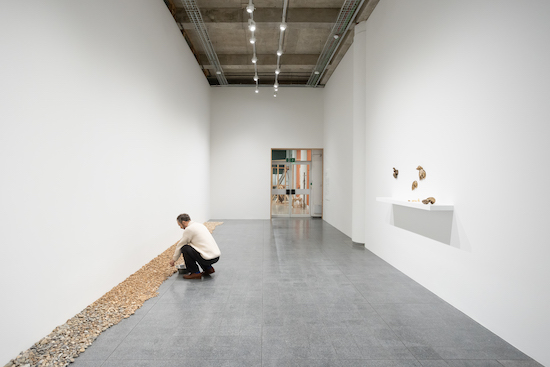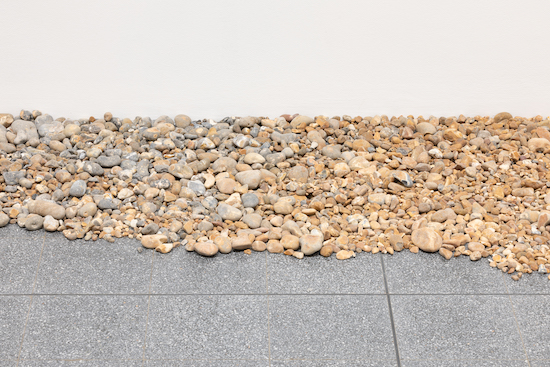Picture credit: Rob Harris/ Brighton CCA
The 1949 Coastal Protection Act makes it illegal to removal pebbles from sea beaches. You didn’t know that, did you? Back in 2018 one visitor to Cornwall took a bag of stones home from a trip to Cracklington Haven only to have St Gennys Parish Council hunting him down. He was informed that if he didn’t return the stones he’d face a £1000 fine. A spokesperson for the council said “it may seem harmless but given the thousands of visitors every year every stone removed could have an impact on coastal erosion, natural flood defences, and wildlife habitats”. So you’ve been warned…
Amalia Pica is well aware of this law and makes it the motor behind her latest work. For rock comb she has borrowed two tons of stones from Brighton’s famously pebbled beach and made a heap of them in a secluded corner of the gallery. The pile itself recalls the untitled dumps of candies, sweeties, famously made by Felix Gonzales-Torres before his untimely death. Pica’s deposit is made to work in a similar way to Gonzales-Torres’ gifted gestures of empowerment; we are asked to get involved, pick up some pebbles. Steel bowls and trowels sit atop the temporary hillock and Pica asks that we fill the bowl and take it next door into the main gallery area. Once there we are to disperse the stones along the border of a wall. Eventually the entire floor space will be covered with a carpet of stones.
The work is colour coordinated – we are to place darker, grey pebbles, to the left and lighter, whiter, stones to the right. The centre is a subtly changing mass of browns and ochres. In contradiction to Gonzales-Torres and his confectionary presents we are not to take the ordinary pebbles home – that law again – but Pica has a surprise in store for the lucky. In the mini-dune we are asked to disperse there are a number of hidden, gilded, golden pebbles. These we can take home, if we like, or place on a small mantelpiece installed in the main space high above the evolving carpet. Given Gonzales-Torres’ history (his works addressing the HIV crisis, his early death in 1996 from AIDS), it’s fitting that Brighton, a city that suffered more than most before the invention of protease inhibitors, is the site of what can be understood as a admirable tribute to the late artist.
And so you bend down, fill your bowl, head into the space and place each pebble where you think it fits in the grand scheme of things. Not difficult then to understand the piece as a metaphor for choice, for discrimination, for co-operation toward a greater good, for knowledge in and off itself. Hard, too, not to see the piece as referring to the Situationists well-worn phrase about freedom, the freedom suggested by the beach lying underneath the paving stones. Here the beach itself is the subject of détournement. In a time of gross economic inequality we are also cheekily reminded that, as with Paris ’68, these stones could be used as weapons.
Pica is interested in shared action, community work. Originally from Argentina, she’s only too aware of the historical trauma of fascist attacks on the masses during the 1970s, the CIA’s Operation Condor with its legacy of over 30,000 disappeared from her country. Some of her earlier collaborative performance works, such as A n B n C (2013), refer to Venn diagrams and how the Argentinian dictatorship behaved during the Dirty War. The repressive authorities made teaching on Venn diagrams in schools forbidden because the concepts of collaboration and intersection, beloved of Pica’s practice, were thought to be potentially subversive.

Pica’s use of trowels and bowls in rock comb also recalls childhood visits to the beach with your bucket and spade. Brighton beach being full of pebbles you can see her action here as a generous gesture to disappointed kids on a day trip, all those nippers upset not to find sand. Pica pays attention to kids and their long-held notions: her work Hora Cathedral (2002) refers to the Casa de Tucamán where Argentina declared its Independence from Spain. Argentinian kids think the building is yellow because that’s how it’s regularly depicted in schoolbooks. In fact it’s white: Pica bathed the real building in yellow light, thus addressing childhood and its misunderstandings, its long-term illusions.
There’s another putative reading to rock comb that refers to the artist’s own surname. Pica is an eating disorder where people consume things that are not foods – commonly stones for example. The condition was known as far back as Hippocrates’ time. The term itself comes from the Latin for magpie – another coincidence given the artist’s stealing from the shore. Although pica sounds genuinely odd, as odd as rock comb itself, there’s the (unproven, risky) suggestion that geophagia might benefit those with a mineral-deficient diet.

As I write, parts of the beach at Brighton between the pier and the marina are being torn up by a succession of diggers as a new outdoor Olympic-sized swimming pool is being constructed. But look closer: those pebbles are being relocated, not removed, to other parts of the beach. The hope is the site will become the first national centre for open-water swimming. One of the local swimming coaches was quoted in The Guardian as saying the pool will be “a fantastic stepping stone for getting people into the sea”, a metaphor Pica would no doubt approve of.
At the show’s end Pica’s pebbles will be appropriately (and lawfully) swept up and returned to the beach.
Amalia Pica, rock comb, is on at Brighton CCA until 4 March 2023


